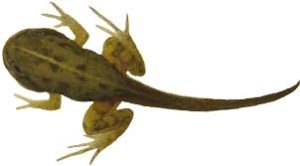09
Aug
Glyphosate Stresses Tadpoles to Produce More Venom
(Beyond Pesticides, August 9, 2017) Common toad tadpoles express more venom when chronically exposed to glyphosate herbicides, a study published last month in Proceedings of the Royal Society B indicates. Glyphosate, an  increasingly controversial chemical found in Roundup brand herbicides produced by Monsanto, has been linked to a range of adverse impacts in both wildlife and people. The results of this research indicate a need to reduce the use of glyphosate in our environment to ease chronic stressors to sensitive wildlife like amphibians.
increasingly controversial chemical found in Roundup brand herbicides produced by Monsanto, has been linked to a range of adverse impacts in both wildlife and people. The results of this research indicate a need to reduce the use of glyphosate in our environment to ease chronic stressors to sensitive wildlife like amphibians.
Scientists tested the effects of formulated glyphosate products on toad tadpoles through experiments in a laboratory setting, as well as a mesocosm, a controlled outdoor environment that replicates natural conditions. Tadpoles in the lab were split into a series of groups which were each exposed to varying levels of glyphosate, some for the duration of the experiment, and others for 9 day periods during different stages in their development. For mesocosm tadpoles, researchers set up large plastic tubs and created small self-sustaining ecosystems with pond water and beech leaves. Glyphosate herbicides were added to certain tubs at either low or high concentrations. Both lab and mesocosm experiments had control tadpoles not exposed to any glyphosate herbicides.
Tadpoles exposed to the highest levels of glyphosate products throughout the duration of the lab experiment were found to have considerably more venom concentration in their bodies than control tadpoles. However, lab results found little correlation between higher venom levels and 9 day periods of glyphosate exposure at different developmental stages. For the mesocosm experiments, tadpoles exposed at high and low glyphosate concentrations had significantly higher venom concentrations than control tadpoles.
Common toads will excrete venom, or bufotoxins containing the chemical bufadienolide, which adversely affects another animal’s heart, in order to ward off predators. Scientists indicate that while higher levels of venom may seem good for the toad, they may cause unintended effects throughout the ecosystem. Increases in toxin concentrations detected after glyphosate exposure were comparable to those seen in other species under predatory threat, which resulted in death to the predator, researchers note. “Although pesticides make toads more toxic, the predator-prey balance and the composition of natural habitats in freshwater, as much as on land, may be altered,” said Veronika Bókony, PhD, an author of the study.
This is not the first instance of glyphosate altering the normal development of amphibians. Earlier this year, the same team of researchers found that glyphosate products reduced the survival and growth of common toads, and otherwise slowed down their development. A 2012 study from the University of Pittsburg found that glyphosate induced morphological changes in the development of leopard and wood frogs similar to those seen under significant predatory threat.
The results of accumulated scientific research on stress-induced changes following glyphosate exposure points to underlying flaws in U.S. regulation of pesticides. Ecosystem-wide impacts caused by the secondary effects of pesticide use are rarely, if ever, considered under the risk assessment framework used to register pesticides.
For alternatives to the use of glyphosate, start with practices that encourage healthy soil, such as mowing high, proper, aeration and proper watering to reduce weed pressure. When cultural practices have been attempted and mechanical means are ineffective or impractical, use Beyond Pesticides’ List of Organic Compatible Products as a guide. And for more information on the impact of pesticides on amphibians, see Beyond Pesticides’ wildlife program page.
All unattributed positions and opinions in this piece are those of Beyond Pesticides.
Source: The Brussels Times, Proceedings of the Royal Society B










